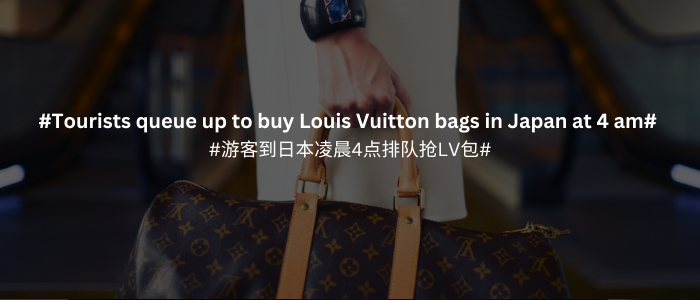Travel & Leisure


In recent years, China’s tourism market has recorded the highest growth in the world. Several factors explain this exponential rise: urbanization, rising incomes, and the easing of travel restrictions. In addition, expenditures abroad have risen sharply due to Chinese tourists’ great propensity to consume, especially regarding luxury goods. Progressively, more and more Chinese people are traveling the world and experiencing different cultures, while, at the same time, a greater number of international tourists choose China as their holiday destination, fostering cross-cultural exchange.
Daxue Consulting had the chance to support major brands operating in tourism, hospitality, and F&B industries in both qualitative and quantitative customer research, sensory research, and VR research, gathering great expertise in such fields.
The Chinese airline industry has shown impressive growth in recent years. The number of air passengers in China has increased from 229 million in 2009 to more than 659 million in 2019. China’s busiest three airports are located in Beijing, Shanghai, and Guangzhou. There are three major national airlines currently operating in China: China Southern Airlines, China Eastern Airlines, and Air China, vaunting annual revenues of roughly RMB 154 million, RMB 120 million, and RMB 136 million respectively between 2017 to 2019. China Southern Airlines is currently the country’s largest airline in terms of aircraft fleet, routes, and passenger turnover. Airlines in China use loyalty programs to capture customers in the long run and increase direct sales.
There are two main sales channels that customers can use to purchase flight tickets: they can either contact an Online Travel Agency (OTA) or book the flights directly through the airline. The aforementioned channels also offer extra services or products, such as additional luggage or travel insurance. In particular, the Chinese travel insurance market is on the rise.
The COVID-19 pandemic had a severe impact on Chinese airlines. McKinsey estimated that between January and February 2020 the number of air travelers decreased by more than 80% and the three largest airlines in China experienced a drop in revenues of roughly 40%-52% from 2019 to 2020. The pandemic did not only drastically decrease the amount of air passengers in China, but also required Chinese airlines to adopt new safety standards and sanitizing procedures.
China has become one of the leaders in the outbound travel sector, and Chinese, as well as Japanese, account for around 50% of all Asian outbound travelers. Thailand, Japan, and Vietnam are Chinese tourists’ favorite destinations, mainly due to their geographical proximity to China and the ease of obtaining visas. In 2016, the growth rate of Chinese travelers to Eastern Europe increased by 226% since traveling in Eastern Europe costs less compared to Western Europe. Instead, nearly 3 million Chinese tourists travel to the US annually. Due to the rising purchasing power of middle-income households, Chinese consumers’ spending on outbound tourism has been the world’s No.1 for 7 years and the number keeps on increasing. In terms of the age distribution of tourists, those born in the 90s and 80s make the majority of overseas tourists. Most of Chinese travelers come from tier-1 and tier-2 cities, over half are female. They generally choose to read travel recommendations before trips, mostly through using popular media platforms specialized in tourism and shopping. These Chinese tourists pay attention to both quality and price, they like customized activities and products offered by local stores.
Thanks to the effective response to the COVID-19 pandemic in the first half of the year, Chinese domestic tourism is recovering step by step. Thereby, most Chinese tourists are opting for travelling domestically. The market recovered by 80% in November, and the number of tourists that visited major tourism spots in China increased by 159% in the second quarter of the year, compared to the first quarter. One powerful driver of this recovery is that Chinese travelers can spend their money on duty-free goods without traveling abroad. Encouraging nighttime activities such as “tourist spot night hours” and “cultural night markets” has become a major driver for Chinese domestic tourism recovery as well. Some content-focused platforms, like Xiaohongshu and Zhihu, have high-quality posts from KOLs and KOCs helping travelers decide the greatest activities to do, while other popular platforms, like Weibo and Douyin, help consumers decide the best destinations. Instead, short video platforms contributed to spark many netizens’ interest in natural scenery as their tourism destination. Thus, a greater number of tourists opted for natural scenic spots, while more and more people started paying attention to safety and health factors during their trips, turning road trips into their top choice.
As domestic tourism and business travel increase, the hotel market in China is far from reaching its saturation point. Most hotels in China are independent hotels concentrating in lower-tier cities. The pandemic has hit hard in the hospitality industry worldwide. Since 2020 Q2, the hotel market in China has shown signs of recovery gradually. The demand for hotels in non-first-tier cities has recovered faster, with post-COVID policies, people were not able to travel too far away from home. Therefore, the overall recovery effect is the best when combined with the rise of surrounding tours.
Tujia is the current leader in China’s home-sharing market, backed by Ctrip.
The company leads the way with around 60% market share, while Airbnb and other local rivals like Meituan Minsu and Xiaozhu trail far behind. While Airbnb made inroads in China mostly at first with inbound international travelers and outbound Chinese tourists to places like Southeast Asia, Tujia has focused on serving a high-end consumer segment looking for domestic travel. Tujia’s main user group are affluent urban residents looking to escape China’s massive cities and enjoy leisurely countryside travel. Tujia’s strategy to recover from the COVID-19 crisis has been to offer aggressive price discounts to acquire users. The company has shift from offering mostly short-term rentals to heavily discounting longer-term rentals.
Tasting local food is often considered as both cultural activity and entertainment, a necessary part of the tourism experience. In 2017, Chinese travelers’ dining expenditure increased by 201% domestically and 14% internationally. Since ancient times, night tours have been an important activity in China. Many attractions integrate local food, traditional performances, and themed night markets. According to Mafengwo, night markets and local street food are the most popular night activities for Chinese tourists: 93.14% of survey respondents say they hope to enjoy the local night markets in every city they visit. During the COVID-19 outbreak, many restaurants and night markets had to close their doors. As life is coming back to normal, night markets have become as noisy as ever, filled to the brim with tourists and locals. In the hope of boosting the international food business, Chinese authorities lowered the tax rate for over 80 food and beverage-related items in February last year, when the country was bogged down in the coronavirus epidemic. As domestic tourism is recovering, we can expect the F&B industry to slowly continue its recovery.
The rapid growth of outbound tourists continues to drive Chinese duty-free consumption. Due to the opening of new airline routes and the general increase in consumption capacity, non-first-tier cities have become the main engine of such growth. Skincare and beauty products are the most popular goods in duty-free shops, however, Chinese tourists like buying premium wine and watches as well. Nevertheless, purchases are usually not due to impulsive buying, since many Chinese travelers skim through online recommendations before purchasing duty-free products. Indeed, more than 60% of Chinese outbound tourists prefer doing shopping in duty-free shops, where they can get high-quality products at a cheaper price. Brands can reach Chinese tourists by launching their own Chinese websites and apps. This allows consumers to shop anytime, anywhere, at their convenience.
Regardless of tourism destinations, the Chinese often spend a large part of total travel expense on cultural activities, accommodation, and shopping. More and more Chinese travelers are interested in both shopping and new experiences. Restaurants, museums, and special performances are key features of their outbound travels.
China is currently on its way to becoming one of the world’s biggest markets for tourism. As the Chinese population ages, the senior tourism industry thrives: around 5 million elderly Chinese people go traveling every yea. With the growing number of tourists traveling abroad, customized travels for Chinese tourists are actively developing.
The outbreak of Covid-19 resulted in a drop of 1 trillion RMB for the Chinese tourism industry. The Coronavirus impact on tourism in China was especially visible among travel agents, hotels, and retailers. Nevertheless, the pandemic opened new opportunities for innovative online solutions: while the COVID-19 pandemic was raging, many scenic areas and museums used live-stream to increase exposure and attract tourists.
In order to compete with the high-speed rail for domestic trips, airlines must leverage new technologies to increase efficiency and improve customer experience. When the new Beijing Daxing International Airport opened in 2019, it included several high-tech features, such as the 5G smart travel system, created in collaboration with Huawei, China Eastern Airlines, and China Unicom. It uses facial recognition technology to increase efficiency and convenience throughout the entire boarding process, while Augmented Reality (AR) glasses improve customers’ experience. This is just a small glimpse of how the Chinese airline industry will use high tech in the future; however, a long way still lies ahead before installing this technology in all Chinese airports.




